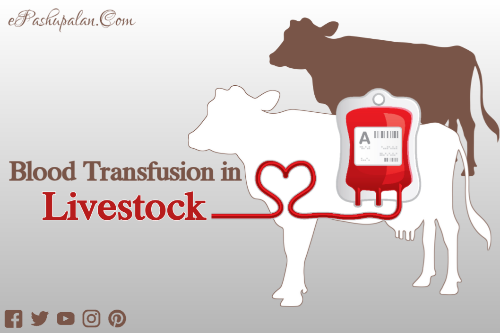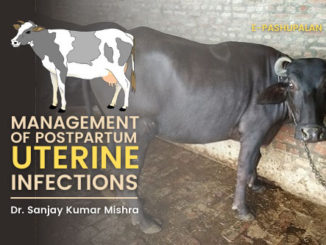Background
History of blood transfusion dates back to 1400 A.D. when Popeimocent VIII was given blood from three boys as a rejuvenator. Now it is an established life-saving therapy in human beings. The start of modern veterinary transfusion medicine dates back to 1950s, when appropriate equipments were available to make blood transfusion practical. In the last few decades, there has been a rapidly growing interest among clinician and research workers in this. In some countries commercial small animal blood banks have been established in addition to the Association for Veterinary Transfusion Medicine.

Indications
- Anaemia
- Acute haemorrhage : Trauma, Accidents, Surgical operations.
- Chronic haemorrhage : Parasites- Haemonchus, Strongyles, Hookworms, Abomasal ulcers.
- Haemolytic anaemia : Theileriasis, Babesiosis, Anaplasmosis, Leptospirosis, Phosphorus deficiency haemoglobinuria, Bacillary haemoglobinuria.
- Bleeding disorders – Thrombocytopaenia, Coagulopathies.
- Hypoproteinaemia – Undernutrition, Parasitism.
- Burns
- To provide specific and non-specific resistance against infection:
- Whole blood is preferred in haemorrhagic anaemia.
- Packed blood cells are good for treatment of haemolytic anaemia.
- In bleeding disorders, hypoproteinaemia and burns, plasma is preferred.
- Serum is the best blood component for providing immunity.
Blood Groups
- Blood types are genetic markers on erythrocyte surfaces that antigenic and specific for each species.
- In animals number of blood group systems are present and some of these systems are complex having many subgroups called factors.
- The number of blood group systems in different species are as follows
- Cattle – 13
- Sheep & Goat – 08
- Horse – 09
- Pig – 16
- Dog – 08
- Cat – 02
- Chicken – 11
Selection of donor
- It should be free from same species and preferably from same breed.
- It should be apparently healthy.
- It should be free from infectious diseases.
- It should have normal body temperature and pink colour eye mucosae.
- It should have high hemoglobin and PCV values.
- The most ideal canine blood donor should be negative for CEA-1, CEA-2 and CEA-7 factors.
Blood Compatibility/Cross-matching
- The blood compatibility testing is done to prevent life threatening antigenic-antibody reactions caused by major blood group mismatching.
- Cross-matching to determine compatibility is not often used practiced in animals except horse and dog.
- In cattle first transfusion can be done without cross-matching however, it is essential if the recipient is given more than one transfusion.
1. Rapid/Direct Method
- Mix one drop of donor’s blood with 3ml normal saline.
- Add 2 drops of above mixture to 2 drops of recipient serum on glass-slide and then gently agitate it for 3-5 min.
- Uniform distribution of cells indicate compatibility.
2. Indirect Method
- Major cross-match : 2 drops of Donor’s RBCs + 2 drops of recipient serum.
- Minor cross-match : 2 drops of Donor’s Serum + 2 drops of recipient RBCs.
- Control : a) Donors : 2 drops RBCs + 2 drops serum, b) Recipient : 2 drops RBCs + 2 drops serum
- Mix the contents of 04 test tubes and incubate for 30 min at 37ºC.
- Centrifuge it at 5000 rpm for 1 min.
- Haemolysis or agglutination indicates incompatibility.
3. Oehlecker’s Biological Test
- This test is suitable under field conditions where cross-matching is not possible.
- Inject 10 ml of blood to recipient and observe for 10-20 min.
- If there is no untoward reaction, then remainder of blood can be transfused without risk.
Blood collection and storage
1. Collection systems :The blood can be collected in –
- Sterile autoclaved saline glass bottles.
- Acid Citrate Dextrose (ACD) / Citrate Phosphate Dextrose, Adenine (CPD-A) readymade polythene bags.
2. Anticoagulants
- Sodium citrate : Suitable for immediate transfusion. It is used @ 10 ml for each 100 ml of blood.
- ACD/CPD anticoagulant : Good for storage of blood and its components. CPD is preferred to ACD because red blood cell viability is prolonged to 4 weeks as compared to 3 week in ACD.
ACD Solution
- Dextrose
- Tri-Sodium Citrate
- Citric acid
- Distilled water
Indications : The solution is autoclaved for sterilization. It is used @15ml/100 ml blood.
CPD-A Solution
- Dextrose
- Sodium citrate (dehydrate)
- Citric acid (anhydrous)
- Monobasic sodium phosphate (monohydrate)
- Adenine (unhydrous)
- Water
Indications : It is used @15ml/100 ml of blood.
3. Site : Preferably from jugular vein using 14-15 gauze needle.
4. Rate of bleeding : Usually @10 ml/kg body weight of donor.
5. Storage : Blood stored at room temperature should be used for transfusion within 4-8 hrs of collection. Blood can be stored for 3-4 weeks at 4ºC.
Administration of blood
1. Routes of administration
a) Intravenous : It is commonly used route.
- Jugular vein is preferred for this route. In dogs, cephalic or recurrent tarsal vein is also used.
- It is satisfactory for treatment of hypovolemic shock.
b) Intra-peritoneal
- It is indicated in shocked and unco-operative animals.
- It is not necessary for treatment of hypovolemic shock.
- There is delay in absorption of RBCs however the cells are observed in an unaltered state.
- It may be of value in replacement of erythrocytes i.e. hemolytic anemia.
- It is not recommended in ascites, peritonitis, abdominal distension and recent abdominal surgery.
2. Rate of transfusion: @10-20 ml/kg/hour.
3. Dose of blood
- It varies with the size of recipient and volume of the blood that is lost.
- It can arbitrarily given @ 10-15 ml/kg body weight.
- Administration of 1 ml whole blood/lb elevates PCV by 1%. (If PCV of donor is 40%).
- Administration of 0.5 ml packed blood cells/lb elevates PCV by 1%.
- The actual requirement of blood is calculated by using either of the following formulae.
- Blood (in ml) required to raise Hb level by 1% = 40 x Body weight in pounds/100
- Blood volume to be transfused = Body weight (Kg) x K x (Desired PCV-PCV of recipient)/PCV of donorWhere, K= 90 in dogs, 66 in cats.
- In most instances, replacing 20-40% of the calculated blood loss is sufficient to maintain life.
Adverse Reactions to Transfusion
A. Causes
- Improper compatibility
- Improper storage
- Improper administration
B. Types of reactions
- Transfusion reactions can be immediate i.e. within 2-4 hours or delayed for few days.
- Transfusion reactions may be immunogenic or non-immunogenic.
a) Immunogenic
- Haemolytic reaction :
- Acute/intravascular haemolysis is characterized by haemoglobinuria, icterus, dyspnoea, tachycardia, lethargy and death.
- Delayed / extravascular haemolysis : It may not produce clinical signs.
- Allergic reaction : Urticaria, pruritis, dyspnoea, vomiting, facial oedema, diarrhea.
- Anaphylaxis : it is very sudden, severe reaction characterized by weak pulse, bradycardia, dyspnoea, urination, defecation, nervous signs and death.
b) Non-immunogenic
- Fever associated with tremor, salivation, lacrimation, coughing, hiccough.
- Hypothermia : It is usually due to use of cold blood in debilitated animals.
- Citrate toxicity : It is used due to massive transfusion of citrated blood at rapid rate and is characterized by hypocalcaemia, restlessness, tremors and cardiac arrhythmia.
- Congestive heart failure in animals with pre-existing heart disease and / or due to rapid blood transfusion.
- Disease transmission through donors.
C. Therapeutic management
- Monitor the recipient continuously for signs of incompatibility during transfusion.
- Stop blood transfusion, if any type of reaction develops.
- Give antihistaminics and corticosteroids, if reaction is mild.
- Inject adrenaline @0.01-0.02 ml/kg IM, if reaction is severe.
- In case of citrate toxicity, give calcium preparations IV @10 ml/lit of blood transferred.
- Consider giving antipyretics, if temperature is high.
- Diuretics are indicated in case of congestive heart failure.
D. Precautions
- Careful selection of healthy donors.
- Keep the bottle rotating during blood collection.
- Perform cross-matching of blood prior to transfusion.
- Administer only needed blood components.
- Warm the stored blood to body temperature before transfusion.
- Filter the blood through sterile gauze, if froth is formed.
- Transfuse blood slowly.
- Avoid giving large amount of blood.
- Give antihistamines before transfusion.
References
- U. Bhikane and S.B. Kawitkar (2016). Handbook for Veterinary Clinicians., Krishana Pustakalaya, 400-408 pp.
- Chakrabarti, A. (2019). Textbook of Clinical Veterinary Medicine. 4th Kalyani Publishers, New Delhi.
- Radostits, O.M., Gay, C.C., Blood, D.C. and Hinchcliff, K.W. (2000). Veterinary Medicine. 9th W.B. Saunders Company Ltd., London.
- Sharma, M.C., Kumar, Mahesh and Sharma, R.D. (2013). Textbook of Clinical Veterinary Medicine. ICAR, Pusa, New Delhi.
| The content of the articles are accurate and true to the best of the author’s knowledge. It is not meant to substitute for diagnosis, prognosis, treatment, prescription, or formal and individualized advice from a veterinary medical professional. Animals exhibiting signs and symptoms of distress should be seen by a veterinarian immediately. |






1 Trackback / Pingback